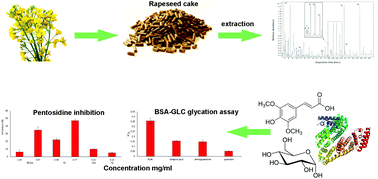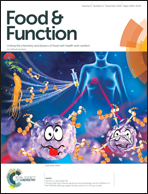Explorative investigation of the anti-glycative effect of a rapeseed by-product extract
Abstract
The formation of advanced glycation end-products (AGEs) in biological systems is increased during hyperglycaemia due to higher levels of circulating glucose and carbonyl reactive species. AGEs are causative factors of common chronic diseases. Since synthetic AGE-inhibitors exert unwanted side effects and polyphenols act as potent antiglycative agents, vegetables (fruits, seeds and related by-products) are good candidates when searching for natural inhibitors. The aim of this research is to explore the suitability of a polyphenol-rich rapeseed cake extract (RCext) to decrease the formation of AGEs in an in vitro model. Different phenols, amino acids, carbohydrates, organic acids and fatty acids were identified in the RCext by GC-MS. The results confirm a high concentration of polyphenols (73.85 ± 0.64 and 86.85 ± 2.08 mg of gallic acid equivalents per g of RCext spray dried and freeze dried, respectively) which is correlated with the antioxidant capacity and anti-glycative activity in a dose dependent manner. Rapeseed cake extract (3.7 mg mL−1) significantly reduced the formation of free fluorescent AGEs and pentosidine up to 34.85%. The anti-glycative activity of the extract is likely to be due to the high concentration of sinapinic acid (0.108 ± 0.0043 mg g−1) in its metabolic profile, and the mechanism of action is mediated by methylglyoxal trapping. The results show promising potential for using rapeseed cake extract as a food supplement to ameliorate the formation of AGEs. Rapeseed cake extract should therefore be considered a potential candidate for the prevention of glycation-associated complications of age-related pathologies.



 Please wait while we load your content...
Please wait while we load your content...